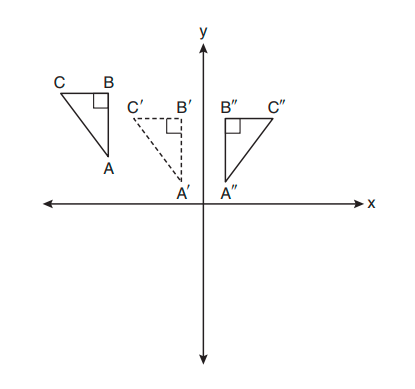Now that I'm caught up with the current New York State Regents exams, I'm revisiting some older ones.
More Regents problems.
Geometry Regents, June 2011
Part I: Each correct answer will receive 2 credits.
1. Line segment AB is shown in the diagram below.
Which two sets of construction marks, labeled I, II, III, and IV,
are part of the construction of the perpendicular bisector of line
segment AB?
1) I and II
2) I and III
3) II and III
4) II and IV
Answer: 2) I and III
To construct a perpendicular bisector, from each endpoint, make an arc above and below the line so that they intersect. That would be points I and III, which is Choice (2).
2. If △JKL ≅ △MNO, which statement is always true?
1) ∠KLJ ≅ ∠NMO
2) ∠KJL ≅ ∠NMO'
3) JL ≅ MO
4) JK ≅ ON
Answer: 3) JL ≅ MO
Contrary to what many overworked math teachers may write on the blackboard (or whiteboard, or whatever), when stating that two triangles are congruent, the vertices are supposed to correspond in the order that they are written.
This means that writing △DOG ≅ △CAT is not the same as writing △DOG ≅ △ACT
So we can assume that J corresponds to M, etc.
Choice (1) is incorrect because K doesn't correspond to M. (The central letter of the angle is the one that's most important.)
Choice (2) is inccorrect because J doesn't correspond to O.
Choice (3) is correct because J goes to M and L goes to O.
Choice (4) is incorrect because J goes to M and M isn't either endpoint on the right side.
3. In the diagram below, △A′B′C′ is a transformation of △ABC, and
△A″B″C″ is a transformation of △A′B′C′.
The composite transformation of △ABC to △A″B″C″ is an example
of a
1) reflection followed by a rotation
2) reflection followed by a translation
3) translation followed by a rotation
4) translation followed by a reflection
Answer: 4) translation followed by a reflection
The triangle moved down and to the right before being flipped over the y-axis. That is a translation followed by a reflection.
4. In the diagram below of △ACE, medians AD, EB, and CF intersect
at G. The length of FG is 12 cm.
What is the length, in centimeters, of GC?
1) 24
2) 12
3) 6
4) 4
Answer: 1) 24
CG is the centroid, the concurrence point for three medians in a triangle. CG is 2/3 the length of CF and FG is 1/3 of the length of CF.
You are given that FG is 12, so GC is twice as large (2/3 vs 1/3), or 24.
Choice (2) assumes the segments are congruent, when they are not.
Choice (3) assumes you thought CG was 12 and they asked for GF.
Choice (4) assumes you thought CF was 12 and they asked for GF.
5. In the diagram below of circle O, chord
AB is parallel to chord
CD.
Which statement must be true?
1) arc AC ≅ arc BD
2) arc AB ≅ arc CD
3) segment AC ≅ segment CD
4) arc ABD ≅ arc CDB
Answer: 1) arc AC ≅ arc BD
If two chords are parallel, then the arcs that they intercept will be congruent. That is choice (1).
Choices (2), (3) and (4) will only happen if the two lines are parallel and equidistant from the center of the circle. In that case, all four statements would be true.
More to come. Comments and questions welcome.
More Regents problems.
I also write Fiction!You can now preorder Devilish And Divine, edited by John L. French and Danielle Ackley-McPhail, which contains (among many, many others) three stories by me, Christopher J. Burke about those above us and from down below. Preorder the softcover or ebook at Amazon. Also, check out In A Flash 2020, by Christopher J. Burke for 20 great flash fiction stories, perfectly sized for your train rides. Available in softcover or ebook at Amazon. If you enjoy it, please consider leaving a rating or review on Amazon or on Good Reads. |
 |
 |




















No comments:
Post a Comment